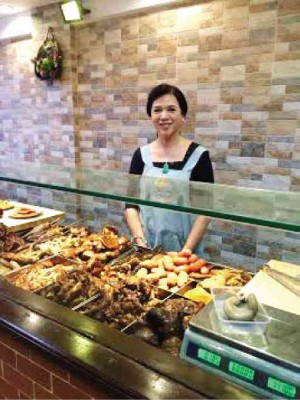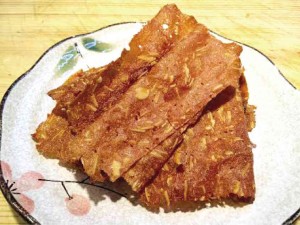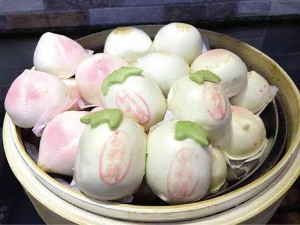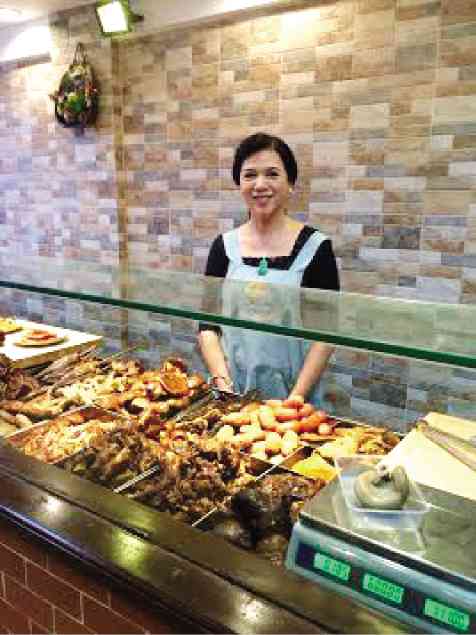
A long counter stacked with cooked bean curds of different varieties, large chunks of assorted meat, offal, mixed mushrooms, seaweeds and vegetables greets you at Jipin Food House.
The sight was exciting and confusing at the same time, as I wanted very badly to try the food but didn’t know how to eat it. Luckily, Taiwanese chef Irene Lee was there to explain it all to me.
Jipin specializes in take-away food that falls under a special category called lu-wei or braised food (“lu” means braised and “wei,” flavors) in Taiwan. Food stalls that serve these dishes as appetizers, bar chow and snacks are found all over the island.
Lee takes pride in her lu-wei creations. She describes the process as simple but tedious. Long hours of preparation and the freshest produce are required to achieve perfection.
Her biggest challenge is to have 30 variants of lu-wei that individually call for specific cooking times and techniques, all ready by 9 a.m. when Jipin opens. Time management is key. The items that take longer to cook are prepared first.
Braising begins by searing the ingredients in a little oil. Afterward, a special soy-based stock that contains about 13 kinds of herbs and spices is added. Each cook has his or her own secret spice blend. The braising liquid is highly aromatic and is used only to cook with, but never as a serving or dipping sauce.
For the flavors to penetrate, the cooking is done over low heat. Once the meats are tender and the other ingredients ready, these are removed from the braising liquid and neatly arranged on the food counter.
I picked the dishes I wanted to try and indicated how much of each to get. Items were then weighed.
The server went to work. Huge chunks of meat were sliced or chopped (depending on what part I requested). The tofu was cubed, the mushrooms spooned and packed in a takeaway container.
Just before he handed the dish over, the finishing touches were placed—coarsely chopped fresh coriander and a drizzling of excellent homemade sauces, such as chili, garlic and a special soy sauce.
Of the items I chose, I loved the pai-ye tofu the most, even more than any of the meat.
“Pai-ye,” also known as hundred-layered tofu, has agar-agar added to it. It is what makes it special. Each bite captured two of my favorite textures, tofu and gelatin. I also enjoyed the tripe, the kelp and the pig’s intestines that tasted clean.
Pork jerky
While Jipin primarily offers braised food, it also has other interesting products such as the paper-thin pork jerky, a family recipe.

Imagine the famous Singaporean bakwa (pork jerky) but paper-thin, speckled with slivered almonds. Lee said Jipin couldn’t seem to keep up with the demand.
Also on display were buns shaped like peaches, radishes and even rabbits, each with a different filling. These buns can be brought home and steamed before eating.
On the opposite side of the lu-wei display were cauldrons of soups and porridges.
I liked the multigrain porridge that had barley, brown rice, oats, cooked with taro and ube. The root crops gave it a nice consistency and a pretty lavender hue. I ate mine with osmanthus honey. This porridge can be served sweet or savory, with pickled vegetables added to it, as regular congee is oftentimes enjoyed.
Of the soups, the very tasty Vegetarian Thick Pork Soup was my favorite. Inspired by the popular maki (pork thick soup), the Jipin rendition was made without pork, of course, but with a lot of other flavorful ingredients to take its place—black fungus, all sorts of mushrooms, soy sauce—all used to give depth of flavor. The radishes added a distinct taste while the carrots lent sweetness to the soup.
Beside the cauldrons was a pan of braised beef, a combination of brisket and tendon, another one of Lee’s specialties. The tendons were meticulously cleaned, marinated in soy sauce, fried, soaked in water for a couple of hours, and then stewed. It is best served with rice or over noodles. The meat and tendons were tender but bland, as Lee warned me they would be.
At Jipin, cooking is done with the intention to keep the food as natural tasting as possible, without MSG and the use of artificial flavorings. People can always season the food as they wish.
Happy Delicious Kitchen

Jipin is Lee’s second food store. The first, Happy Delicious Kitchen, is a place I have been patronizing for years. It is a turo-turo that serves home-cooked Taiwanese food. Its spread looks and tastes good—the vegetables are green, the sauces very rich and vibrant, the fried items nice and golden.
Lee makes it a point to be physically present in every aspect of the eatery’s operations—from sunrise when she leaves for Arranque Market, to sunset when she heads home to cook dinner for her family.
She shares her multigrain porridge recipe.
Multigrain porridge
1 c multigrain rice mix (available at Shin Tai Shang, a Taiwanese store beside Jipin)
3 c water
100 g ube, diced
100 g taro, diced
5 c water (adjust according to desired consistency)
Cook the 1 c of multigrain rice in a rice cooker with 3 c of water.
In a separate pot, bring 5 cups of water to a boil. Add ube, taro and the cooked multigrain rice.
Cook, stirring, until thick. Serve with honey, brown sugar or Chinese pickled vegetables.
Jipin Food House is at 817 Salazar St., Binondo, Manila. Call 2559306.
Happy Delicious is at 801 Benavidez St., Binondo, Manila. Call 2440120.
Shin Tai Shang is at 815 Salazar St., Binondo, Manila. Call 2440325.












































